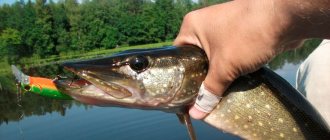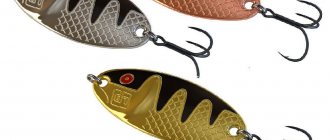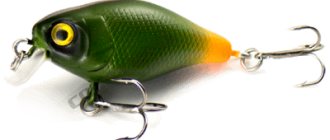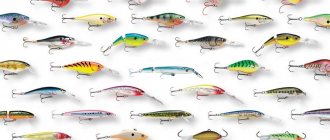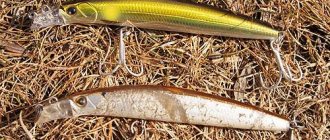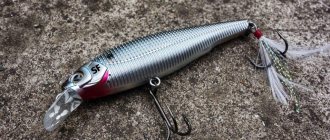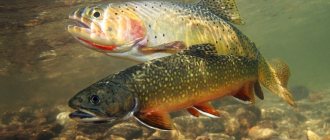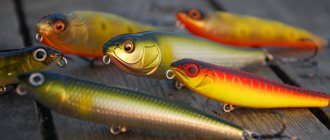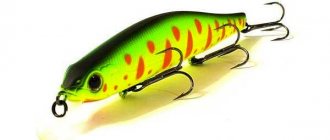How to retrieve a bait
For each type of bait, there are several basic wiring options that need to be tried first.
At the same time, while fishing, you shouldn’t get hung up on one thing: if there are no bites, you can first try changing the wiring, and then, if none of the animation options work, change the bait itself.
But the main rule of fishing when fishing with a spinning rod is the need for constant search and experimentation - only this will allow you to fully reveal the potential of a particular bait.
Fishing with wobblers
Wobbler selection
All the variety of these baits requires certain skills, abilities and good knowledge of the reservoir. Since not every angler can afford to have a whole box of “fish for all occasions,” to select a wobbler, determine the following characteristics of the reservoir:
- depth;
- current speed;
- water color.
For deep areas and murky water, choose bright colors. For fishing in the current, do not take wobblers with large “blades” and excessively high frequencies - their play will be disrupted. It doesn't hurt to know what kind of fish you want to catch. Pike loves large slow-moving baits, pike perch loves elongated mines for bleak, and give perch any little thing, as long as it moves quickly. Finally, I will say that before buying something new, I first try to get as much available information as possible and only then finally make my choice.
Now a few words about the cons. The only but huge disadvantage of wobblers is their price. I'm not talking about cheap Chinese fakes for $1.5-2. For example, it is said that I began my acquaintance with Chinese baits, which flooded all markets. I bought a dozen, came to the river, tested them one by one, and a little later threw them all in the trash.
The reason is the lack of play (they float like a piece of tied wood) and, as a result, a zero result. Therefore, I advise you, it is better to buy one branded working wobbler, and not ten Chinese ones, and do not repeat the mistakes of others!
- Why are you so happy? — Yes, my mother-in-law gave me a carbon fiber spinning rod for February 23rd! - So she hates you!? — And for several days I was shouting: I hate carbon fiber spinning rods! God forbid someone gives you a carbon fiber spinning rod!…
Wobbler - an atypical bait (wiring technique)
A wobbler is one of the most difficult baits to control and has high drag. Frontal resistance is the most important characteristic that determines the possibility of its use when catching a particular fish in various bodies of water. All baits have drag, but it is most noticeable in bladed wobblers with a depth of more than three meters.
Main types of spinning rods
Uniform
Uniform wiring is the simplest version of spinning wiring . Fishing with this type of fishing does not require much spinning experience or any special skills - basic skills in using spinning tackle will be enough.
After casting, you need to let the bait sink to the desired depth , and then begin to rotate the reel handle at the same pace , reeling in the line. With uniform wiring, the nature of the bait's play is determined by its characteristics , and not by the fisherman.
The speed of reeling in the fishing line is selected based on the fishing conditions and the characteristics of the bait: you must strive to ensure that the bait goes at the desired depth and plays in the best possible way, attracting a predator.
Uniform retrieving can be diversified by periodically pausing in reeling in the fishing line or jerking the rod. Often used (and bites occur precisely during pauses or immediately after jerks).
Classic stepped
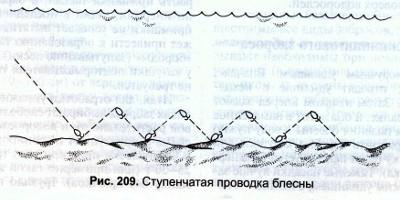
The wiring is done at the very bottom. After casting, you need to let the bait sink to the ground , and then make several (usually 2-3) turns of the reel handle , reeling in the fishing line. The bait rises from the bottom and swims some distance. After this, you should take a short pause to let it fall again, and rewind the line again .
Snatch step
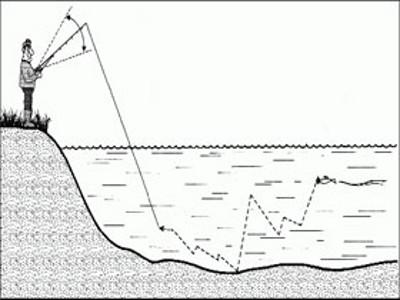
Jerk step retrieve is very similar to the classic step retrieve, but there is an important difference: it is performed not with a reel, but with a rod.
That is, after the bait falls to the bottom, the spinner makes a swing with the tip of the rod (after which the bait makes a jump under water) and pauses, allowing the bait to sink to the bottom and taking out the slack in the fishing line . Then follows a new jerk with the spinning rod.
All these actions are repeated again and again, until a new cast.
Stop-and-go
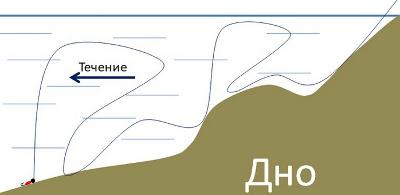
After casting the bait and reaching the desired depth, you must perform several (usually 4-5) turns of the reel handle , and then pause for 2-3 or more seconds . Next, you should make a small jerk with the tip of the rod and start reeling in the line again . Bites most often occur during pauses.
Uneven (wavy)
To perform wave-like retrieving, you need to rotate the reel handle at the same pace , evenly reeling in the fishing line, and at the same time make smooth swings with the tip of the spinning rod (the directions of movement of the rod can be different - for example, up and down or back and forth).
In this case, the bait will move along a kind of “ wave-like trajectory ”: rushing up and down, while maintaining one horizon throughout the entire retrieve.
This wiring option works well when fishing with rotating spoons and spinnerbaits (the petals of these baits on wavy wiring rotate either faster or slower, which can attract a predator that does not respond to uniform wiring), as well as other baits.
For demolition
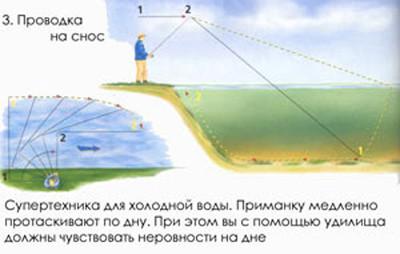
It is necessary to cast a little higher upstream and let the bait sink to the bottom . After this, the spinner makes a swing with the rod , after which the bait rises above the ground and floats downstream for some distance , and then sinks to the bottom again . Then follows a new swing with the form.
When performing this wiring, it is necessary to rewind the slack in the fishing line in a timely manner so that the cord is always taut - this will allow you not to miss the moment of the bite and make a timely hook.
There is another option for drifting: the cast is made downstream, and after each swing of the rod the fisherman releases a little fishing line from the reel, thus giving the bait the opportunity to float freely with the flow.
Twitching

Wobblers specially designed for fishing with jerk wiring often do not have their own game at all - they “come to life” only when twitching . You can also use twitching when fishing on models that play well on a uniform retrieve.
When performing a jerk retrieve, the spinning angler rotates the reel handle at the same pace, reeling in the fishing line, and at the same time jerks with the rod. At the same time, the wobbler makes throws from side to side and various pirouettes in the water column. Twitching bait perfectly imitates a wounded fish, attracting a variety of predators.
Jerking
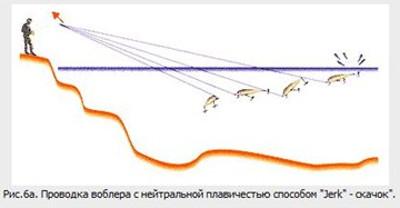
When performing a jerk retrieve, the spinning angler makes a quick jerk with the rod (at this time the bait makes a sharp jump forward and to the side underwater) and immediately reels in the fishing line , picking up the slack. This is followed by a new breakthrough.
You can diversify this wiring by periodically changing the direction of the rod swings (and, accordingly, the direction of movement of the bait).
Ripping
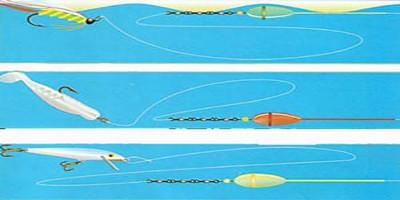
When performing a ripping retrieve, the angler makes wide strokes of the rod from top to bottom . With this wiring technique, the wobbler will go noticeably deeper than with twitching.
A short spinning rod is best suited for ripping .
What is wobbler. Where to begin…
Good afternoon fellow hobbyists.
I am an avid wobbler, I fish in the summer in 99% of cases with these plastic (sometimes wooden) baits, and I fish quite successfully. Over the years of mastering this particular type of fishing, we have come a long way in understanding what a wobbler is, how to use it correctly, and how to choose the right bait for certain conditions. And very often on the river I see people who are just beginning to master this type of fishing, I see mistakes that I myself have made before... Therefore, the idea arose to share a little of my accumulated personal experience, in the hope that this will help someone in the initial stages of mastering this fascinating type of fishing... All the information presented below is, in principle, available on the Internet, but in fragments, I decided to collect everything in one pile and present it in simple human language. Therefore, people with more or less experience in this matter are unlikely to be interested in reading further...
And I want to say right away that I have been fishing only with wobblers for many years, I will never say that I know everything in this kind of fishing... no and again no... The wobbler is a very multifaceted bait that will force you to turn on your brain, and this is the most interesting thing, in my opinion... What I mean is that you don’t need to take everything I’ve written as the ultimate truth, there is always a place for experimentation, and perhaps in your conditions and places, something will work perfectly differently…
How does a wobbler differ from other fishing lures? Mainly because the wobbler can work in the water column, at any depth level, and not just along the bottom. The wobbler allows you to take very long pauses, retrieve very slowly, and play with the bait practically without moving it from its place. It is simply impossible to do this with a jig or spoon. This type of bait is intended for short-range fishing; the casting distance rarely exceeds 40-45 meters.
How to use a wobbler correctly - or rather, in which places its use is more justified: these are shallow bays, channels, lakes, shallow sections of the river, riffles, small rivers... At the same time, I will in no way say that in other places the wobbler does not work, it’s just in such places that it’s worth starting to master wobbler fishing, and only when an understanding of the behavior of the bait begins to occur, you can complicate the conditions. In no case should you start learning how to fish with a wobbler on the fairway, in deep water in broad daylight from the shore, most likely you will not catch anything and will be disappointed in the bait. My advice is to start, find a shallow “pike” place with the most clear water, so that you can see how the wobbler behaves, what happens to it during your manipulations with the spinning rod, try different wiring, without neglecting evenness... then understanding will slowly begin to come on its own yourself, the main thing is not to forget to “turn on” your brain. As for the Ob and OVKh, there are practically no places for wobbler fishing from the shore, so having a wading suit or a boat is simply a must. Then analyze “your” places where you fish, what depths you have, what the bottom topography is, how cluttered it is, and based on this, purchase bait. There is not the slightest point in buying vobs that are not suitable for your conditions, well, if only for a collection, but that is a completely different story. A small example - the average depth is 1.5 meters, the bottom is rocky (and therefore hooky), then the best choice would be a pair of wobbles - with a depth of 0.5 meters and 1 meter, respectively, with greater depth the wobble will cling to the bottom, and sooner or later you will catch it If you tear it off, with less, most likely the fish standing at the bottom will simply ignore it. And using approximately the same logic, you select an arsenal to suit your basic conditions.
And in no case should you start by buying openly “Chinese” products, they are not always successful, often requiring fine-tuning and “filing”, and this is by no means for beginners... I’ll put this in a separate paragraph, my IMHO this is exactly this point very important . Don’t be afraid of the high price of a wobbler (relative to silicone, for example), if the bait is correctly selected for the place, it is impossible to tear it off, well, almost... For example, I lose on average 5-7 baits per season, which when compared financially with jig fishing, where for fishing On average, a pack or two of silicone comes off, not a lot. It’s better to have ten wobbles from proven producers than fifty of who knows what... This is a very common mistake among anglers.
Now a little about the types of wobblers, there is a lot of information about this, so I will try to briefly and about the main thing
1) The most common type is the minnow - a long, narrow-bodied bait - the most versatile type of wobbler, but at the same time the most difficult to master and understand.
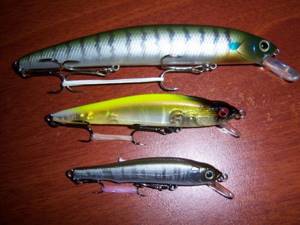
2) Crank - a short-bodied thick bait - usually with a very active game, in my opinion the easiest bait to understand, which often does everything itself, without requiring any super skills from the angler. But it doesn’t always work on fish, mostly only on active ones, so it’s a must have, but it won’t be a panacea for anyone.
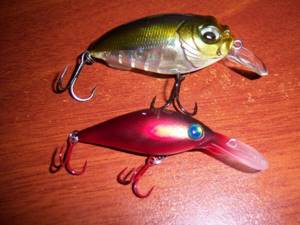
3) Shad - a “flattened” crank, or a minnow stretched “in height”, to be honest, it’s not a completely “understandable” bait for me personally, there are several in boxes, sometimes they shoot, but I don’t really like it, because special shapes generally do not fly very well, although there are a couple of exceptions.
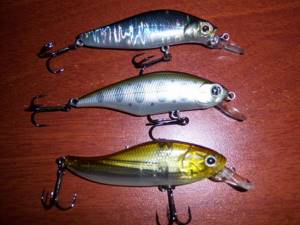
4) Component - maybe a minnow, a crank, or a shad, the essence of such a wobbler is a more natural, “live” game. But in such wobbles, the long-casting system is either “cut down” or absent, due to the multi-component body, so they almost always fly worse than the same, but solid-bodied wobble, and at the same time they require some skills when guiding, so at the beginning I didn’t I would advise you to acquire a large number of such baits.

5) Popper is a surface bait with a “squish” that, when jerked, makes a gurgling sound and splashes. You need to have at least one, sometimes it is the popper that brings the perch to the zhor, and the pike out of its stupor.
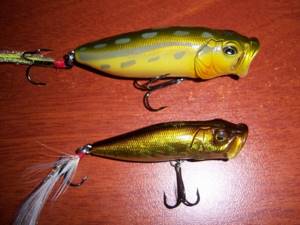
6) Walker - again a surface bait, which, when retrieved, glides along the water surface from side to side, creating the impression of floating living creatures.
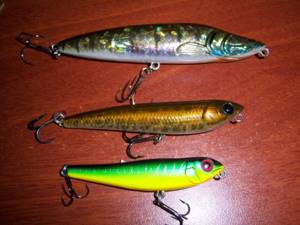
7) Further you can list - jerks, swimbaits, ratlins, propbaits, chatterbaits, various hybrids of popper and minnow, walker and popper, and so on. My opinion is that this is not at the very beginning of the “wobbler” journey, these are all very interesting and effective baits in skillful hands, but I repeat, not for the beginning...
Further wobblers are:
1) Floating - that is, during a pause the wob will float up, while retrieving it will go within the horizon specified by the manufacturer and the fisherman, namely, it will float up during the pause. For what ? If we ignore the fact that the fish often rushes to the bait precisely at the moment of surfacing, this is also very useful when avoiding underwater obstacles during retrieving - any underwater vegetation, a hill, a stone, in the end. Having brought the bait to the obstacle, you let it float up, and calmly go around the obstacle, then again deepening the bait to the desired horizon. Or it simply allows you to move the bait with a depth of, say, 1 meter at a depth of 50 cm, simply making a slow retrieve with long pauses.
2) Suspender - that is, when paused, the wobble “hangs” in the water column; ideally it should neither float up nor sink, but as a rule, in practice, such a wobble either slowly sinks or slowly floats up. What is it for ? To be able to hold the bait for as long as possible in a specific place, in the field of view of our prey. My favorite type of bait, most often the fish are cautious, and it is the behavior of the suspender in the water that is most to their liking.
3) Sinking - during a pause the wob sinks, at different speeds, but sinks. BUT he does this only during a pause; during reeling, the wob moves in the given horizon. Why this behavior? Let me give you a simple example: the background depth at the fishing spot is 1.5 meters, but in the middle there is a hole with a depth of 2.5 meters. We take a sinking wob with a given depth of 1.2 m, move it at an average pace, fishing for the background depth, bring it to the edge of the hole, give a pause, bury the wob in the hole, and fish the relief. That is, the behavior and tasks are absolutely opposite to the floating bait. This time. And secondly, it is sinking vobs that are simply necessary in places with strong currents; as a rule, they are not carried to the surface, and they work stably, without straying, in these difficult conditions.
Another important factor is the size of the wobblers, which is also selected relative to the time of year, location and intended production. You can argue for a very long time about the size of the wobbles, for starters, I suggest limiting yourself to the size of 70-110 millimeters, and later you will understand for yourself what you like best and in which direction to move further, to reduce or increase. Personally, I liked the light one more, so most of the wobbles in the box are 50-90 mm. The general principle is to gradually increase the size of the bait from spring to autumn, as the natural prey of predatory fish increases. But this is far from a dogma, sometimes in the spring the hundredth size works, and in the fall a 50mm bait is held in high esteem.
You can argue for a very long time that there are wobblers with active play, with passive, purely twitch (jerk), which, on the contrary, work only at a uniform pace, but my IMHO is that these are already more secondary factors, it is much more important to choose the right wobbler for specific conditions, and already on a correctly selected wobble, select the required pace of the game... and not vice versa...
This is probably all the information that is necessary to start mastering wobbler fishing, analyze your main fishing spots, purchase baits consciously for certain conditions, try, think and you will succeed, not right away of course, but with due persistence, definitely...
I didn’t specifically talk about any specific baits, everyone has their own favorites, there are a lot of worthy companies, and it won’t necessarily be something expensive…. I really hope that this information will be useful, for me everything written seems simple and understandable, but for a person who has recently become interested in wobbler fishing, I hope this information will help avoid mistakes and quickly master this most exciting type of fishing.
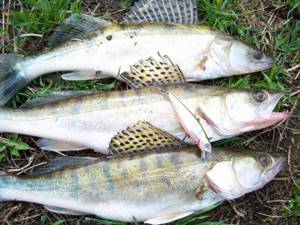
Good luck on the ponds.
Sincerely, Igor.
Wobbler animation
Wiring wobblers for beginners
Wobbler fishing for beginners. Wiring technique:
- uniform wiring;
- acceleration wiring.
Most wobblers work well with even wiring . These models come out onto their working horizon and play, attracting a predator. But for wobblers that do not have their own game (twitching wobblers), uniform wiring is not suitable.
When retrieving with acceleration, the fisherman reels in the fishing line, rotating the reel handle either faster or slower . In this way, you can tempt a passive predator to bite.
Wiring with acceleration, like uniform wiring, is not suitable for wobblers that do not have their own game.
Wiring a “lazy” wobbler
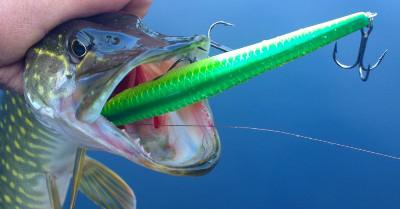
It is necessary to reel in the line at a slow pace, while simultaneously making smooth twitches of the rod tip . From time to time you can lift the spinning rod up - at this time the bait looks like a fish running away to the surface.
Drowning animation
So, what types of fishing are there when fishing with a sinking wobbler? In addition to the standard methods of guiding wobblers - uniform, wiring with acceleration, twitching, ripping and jerking - you can use the “free fall” technique to animate a sinking wobbler .
In this version of the animation, after casting, the wobbler is allowed to sink to the bottom, slightly moving it with strokes of the rod tip . This technique is suitable for spot fishing of gaps in the grass, as well as holes, snags and similar promising places.
Posting floating
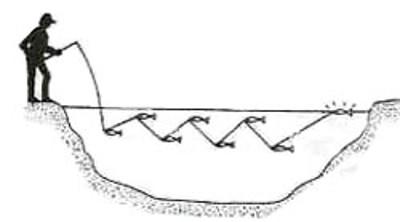
Also, this type of wobblers can be floated with the current , which can be used both to deliver the bait to the desired point (for example, under the branches of trees and bushes hanging low over the water), and as an animation option when the angler slightly moves the tip of the spinning rod floating through the water wobbler
A floating 4-5 gram wobbler, which is great for catching chub and ide with ultralight tackle (but you can also hunt perch or pike with it), can be animated in different ways. Some will say that it is better to drive it at a slow pace, while others, on the contrary, prefer fast driving.
In fact, it all depends on the specific model of bait and the specific situation (weather, current and depth, fish activity in the reservoir). For minnow-type wobblers, twitching is usually preferred; shorter and thicker models often work better on a jerk retrieve.
Minnow wiring
The main option for wiring minnow wobblers is twitching . It is with jerk wiring that minnow-type wobblers are primarily associated. A specific twitching option (faster or slower retrieval, sweeping or small-amplitude spinning swings, sharp jerks or smooth pulls) must be selected for each bait and fishing situation separately.
In addition to twitching, you can use other types of wobblers with minnows.
Posting by casting
On wobblers, manufacturers often indicate the recommended method of wiring - casting, twitching. And novice fishermen wonder what is casting a wobbler.
In fact, the term “casting” refers to casting . There are also special casting competitions among spinning players, in which participants must perform the most accurate and long-range throws.
If the bait says “casting, twitching” fishing, this means that this wobbler is designed for casting with jerk animation.
Adjusting and tuning the wobbler
Finishing, tuning, adjusting the wobbler Regularly in the forum there are messages of the following kind: “The wobbler is good, but does not hold the current - it falls to one side,” and then the conclusion follows that this wobbler is defective. And it’s not uncommon for this to be written by spinning players who are not beginners, but experienced ones. This surprises me a lot. Any wobbler, even the most expensive one, must be checked for the correct position of the loop immediately after purchase and further on the river if it still tilts, even a little. This is the LAW. Factories have their own tolerances and errors. And even branded models have their own percentage of defects...
As you know, a lot depends on the position of the front loop. By moving it laterally, you can adjust the errors in the shape of the blade, body geometry and balancing, which is why the wobbler can tilt in one direction or another. That is, the position of the loop can deviate from the strictly central one in one direction or another. Below I will describe how to fix this. As a result, a correctly adjusted wobbler should go straight, strictly in a vertical position, without losing its play during acceleration and even when changing the direction of movement.
A little about the wobbler blade Since we’re talking about adjustment, let’s also remember about other important elements of the wobbler, such as the blade. The size of the blade and its location is undoubtedly one of the main parameters, along with the location of the loop and the loading and balancing of the wobbler. I will try to briefly describe the dependence of the wobbler’s play on the shape and inclination of the blade:
The wider the blade, the greater the amplitude. That is, it plays wider and more aggressively (the wobbler “knocks” on the hand”). The smaller the blade width, the higher the frequency. That is, it fluctuates faster and smaller, and the game is less intense. The steeper the blade angle (more vertical), the greater the amplitude. That is, it plays more widely and powerfully. Depth: the more vertical the blade is, the closer the wobbler will go to the surface. And vice versa: the lower the inclination of the blade (more horizontal position), the more the wobbler will go deeper. And with the same parameters, a wider blade will have greater depth. For deep models, the longer the blade, the greater the depth. Width combined with length form the total area of the blade, which affects all parameters in direct proportion. Also, do not forget about the accompanying, “secondary” characteristics, such as the “persistence” of the wobbler. In addition to the proportions of the body, it depends on the width of the blade and the activity of the wobbler. Many people take this parameter literally - it’s hard to turn the reel. J But the important thing is that a persistent wobbler creates large hydro-acoustic disturbances - it pushes the water in front of it more strongly, leaving behind a more noticeable “turbulent” trail and is thus detected much faster by the fish. But this is not always necessary... The blade also affects the parameters of the jerky “yaw” retrieve, the speed of penetration and even the vertical position of the wobbler in the water (remember “Hardcore”). In summary: the blade is one of the most important elements of the wobbler, which affects all the characteristics of the bait.
Wobbler front loop
Next is the location of the front hinge. There are two types of its placement - on the nose of the body and on the shoulder blade. What is the difference? The shift to the scapula is essentially forced. When, in order to obtain the necessary parameters of the wobbler, you need to lower the loop lower, but there is no longer room on the body (nose) of the bait (the blade does not allow lower), then the loop is transferred to the wobbler blade. The essence is shown in the diagram. As a result, it turns out that the greater the distance the loop is displaced along the blade from the body, the lower it is located.
And now about the dependence of the wobbler’s playing parameters on the height of the loop. This parameter is the most accessible for adjusting and fine-tuning the wobbler’s play. The location of the loop is the distance between its center (the fishing line attachment point) and the insertion point of the blade. So the dependency is as follows:
The higher we move the loop, the higher the frequency becomes. And vice versa, the lower we go, the lower the oscillation speed. The lower we lower the loop, the more active the game becomes - the amplitude increases, and the frequency of oscillations decreases. Influence on depth: the lower the loop, the deeper the wobbler goes. The lowest location, as I wrote above, is placement on the blade. The farther the loop is from the body, the deeper the wobbler goes. As you probably noticed, loop displacement affects three factors at once - frequency, amplitude and depth. All to varying degrees, but nevertheless they are all interconnected. Therefore, you have to look for the most suitable option for you or the only possible compromise. For example: when the loop rises, the game becomes more high-frequency, but the activity of the game decreases, up to a complete stop. And vice versa: you can increase the activity of the game by lowering the loop, but again up to a certain point - beyond a certain limit the wobbler loses stability and begins to stray from the game (“scouring around”). And do not forget that all parameters also, and even to a greater extent, depend on the geometry and location of the blade and, of course, on the shape of the body and balancing.
Loading and balancing the wobbler
I will not consider the types of wobblers by body shape, otherwise the size of the article will double, but you need to dwell a little on the load, since this parameter can also be adjusted if desired, thereby significantly changing the performance of the wobbler. The load performs three functions - this is, of course, the mass of the bait, which is important for casting indicators, then the sinking characteristics of the bait, and finally the balancing of the wobbler, which has a great influence on the pattern of the game and other indicators. The location and distribution of the load are the most important parameters and are specified at the design stage by the manufacturer. What does balancing affect?
The simplest thing is flight characteristics. The location (concentration) of the load in the tail of the wobbler makes it fly tail first, stabilizing it in flight. The next thing is the stability of the wobbler - the lower the load is located and the greater its mass, the more stable the wobbler is in the current. Next, the influence on the nature of movement during jerking. The closer to the tail the center of the load is shifted (or spread to different ends of the body), the more pronounced the “yaw” movements (turns to the sides) will be. For some models, the inclined position of the wobbler in the water, relative to the longitudinal axis, is also important, which is also regulated by the load. And finally, the main thing is the character, the pattern of the wobbler’s game. In comparison with the shape of the body and the geometry of the blade, this dependence may not be so significant, but it is the balancing that can become the last, decisive “stroke” in creating a catchy model. When a wobbler works perfectly at first glance, but doesn’t catch anything, it makes sense to experiment with additional weight. These are the subtleties of adjustment, but there are also simpler examples of application. For example, an “unstable” wobbler.
Recently, two models have been modified: Strike Pro MG-002, Hypnose SSR. In the first case, the wobbler simply did not catch. It turned out that it was not entirely stable, which was almost invisible visually, but it was enough for the chub. After experimenting with the placement of additional weight, I stabilized the game with a small piece of sheet lead glued to the belly of the bait closer to the tail. Along the way, the design of the game changed - it became more similar to the work of the famous “forty-fourth”.
The SSR model from the Hypnose Pontoon21 series of wobblers also suffers from a similar “disease” - it “does not hold the stream.” Without modification, the SSR works stably up to a certain retrieve speed, but in fast currents or acceleration of reeling, the wobbler simply turns upside down. Adjusting the loop did not help in this case and I had to fix a piece of lead in the area of the lower loop (the photo shows a temporary additional load during the adjustment process). The game has stabilized 100%. But do not forget that such additional loading inevitably changes other indicators - sinking properties, depth parameters and, of course, the game pattern. When creating my “creative” plasticine wobbler, where the center of the load is very easy to move when adjusting, I was convinced how noticeably the pattern of the game changes when it is moved, for example, to the tail or to the head.
Practical recommendations.
Finally, let's summarize. Any wobbler can be modernized beyond recognition by changing the shape and inclination of the deepening blade, the location of the front loop and additional loading. Therefore, such adjustments must be approached with caution and thought, which firstly concerns changes in the shape of the blade. But often modifications are simply necessary, such as adjusting the front hinge. Below are practical recommendations.
1. The wobbler falls on its side. You need to bend the loop in the opposite direction from the one into which the wobbler falls. That is, if it turns over with its belly to the left, then we bend the loop to the right side. Usually a very small edit is enough. I remind you that checking the correct lateral position of the loop is required for ALL wobblers.
2. You are not satisfied with the frequency, amplitude of oscillations of the wobbler or its depth. This year I had a similar situation with the Gripp 55 model from River2Sea. The wobbler is considered SURFACE and, in theory, should be deepened to 40 cm. But this did not happen - no matter how hard I wanted, I could not deepen it even 5 centimeters. And in terms of play, upon closer examination, he differed from his catching brothers. It was obvious that there was a manufacturing defect, which was expressed in a large protrusion of the hinge forward. I easily cured this illness in the following way.
Since the loop of this wobbler is thick and it is simply unrealistic to straighten it without the risk of breaking the wobbler, I used a low-power soldering iron. I needed to sink the loop into the body of the bait, and to increase the depth, also lower it down a little. We warm up the soldering iron and gently press the loop in the desired direction. As soon as you feel that the loop has given way, immediately remove the soldering iron and fix the position of the loop, for example, with a screwdriver, until the plastic cools down, making sure that there is no movement to the side. After this operation, carefully melt the hinge attachment point if surface defects appear there. Then we cover this place with 2-3 layers of varnish. Done, you can fish. In the same way, using a soldering iron, we adjust the lateral position of the loop, made of thick wire, which is risky to bend with pliers, as it can burst the fragile plastic of the bait body.
To avoid damaging the wobbler by repeated heating and moving the loop, you must first determine the position of the loop as follows. When testing, we attach the wobbler to the cord without winding rings, fasteners or loops on the fishing line, and knit it with a rigid knot so that it does not get mixed up in the loop. By raising or lowering, turning the knot on the loop to the sides, we imitate its movement. This way you can determine where and how much to sweep the loop.
3. Adjustment using additional weight. Defect - the wobbler “does not hold the stream” and gets lost in play. Editing the loop doesn't help. First, you can try to increase the load by replacing the lower tee with a larger one. If this does not help, then the approach is more drastic - “lead”. An example is described above - adjusting Hypnose SSR. You need to add weights at the bottom of the wobbler. The lower, the smaller the load required. The simplest option for attaching the weight, on the forend of the tee, is the lowest point. Simply wraps a thin lead plate around the fore-end. But a more aesthetic and, in my opinion, correct way is to mount a wobbler on the belly. We cut out the lead plate, cut an elongated rectangular hole in the center and, having removed the tee, temporarily attach it to the abdomen, for example, using a thin layer of plasticine. Next, we test the wobbler by adjusting the position of the plate, moving it back or forth and achieving the least impact on the game or choosing the most attractive option for playing the wobbler. We also gradually reduce the weight of the plate to a minimum. When you are satisfied with everything, glue it with waterproof glue and paint it to match the color of the model. Done, you can fish.
4. When nothing helps, you can take the risk of correcting the position of the blade itself. This is a deadly operation for a wobbler. The first attempts can be fatal, but with experience you can get better at it and work wonders, creating real masterpieces from Chinese “blanks”. So, let's try. You can heat it with steam, a hot air gun, or simply with a lighter. The main thing is to heat only the spatula! If the body of the wobbler itself softens, then when adjusting the blades, the walls of the wobbler’s body will move, which means that it can be thrown out. Therefore, we heat it carefully and evenly on all sides. It is better to bend with special pliers with smooth jaws. Try it first on an unnecessary model, since this method is quite complicated and I, for example, almost gave up on it.
Well, that's probably all. I recommend that you take out your boxes of wobblers and test them in the bathroom. You'll likely be surprised how many lures require adjustment.
Popper wiring
The popper on the wire should move in leaps and bounds, spraying water with each jerk and making a peculiar gurgling sound.
Classic popper
The fisherman evenly rotates the reel handle , reeling in the fishing line, and at the same time makes soft jerks with the tip of the rod .
This wiring can be considered as one of the twitching options.
Slow
Retrieving is performed at a slow pace, with the angler making a large number of pauses.
While stopping, you can slightly move the popper with the tip of the spinning rod.
Chaotic
The fisherman makes a series of sharp jerks with the rod, and then pauses. This is followed by several more jerks.
Posting spinners
When fishing with spinners, the following are most often used:
- uniform wiring;
- wavy wiring;
- step wiring.
Uniform
Rotating spinners are primarily designed for fishing with even action . Performing a good, uniform retrieve is not as simple as it might seem at first glance - it is necessary to guide the bait near the very bottom, so that it periodically touches the obstacles lying at the bottom with its petal.
They are caught with even fishing and with oscillating spoons.
Wavy (uneven)
Wave-like wiring is often used when fishing with rotating spoons . It is capable of tempting a predator that does not respond to a uniformly moving bait to bite.
Stepped
Stepped wiring brings good results when fishing with heavy spoons . With its help you can very effectively fish the lower horizon.
Jig wiring
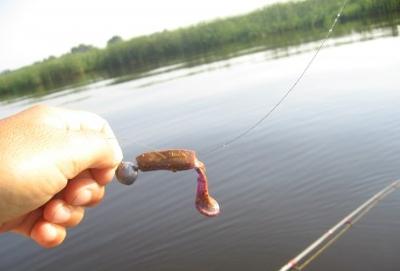
At the same time, the bait moving in jerks best imitates a sick, weakened fish, which is an easy prey.
The main jig movements when fishing with a jig are those described above:
- classic stepped wiring;
- wiring for demolition;
- jerky step wiring.
